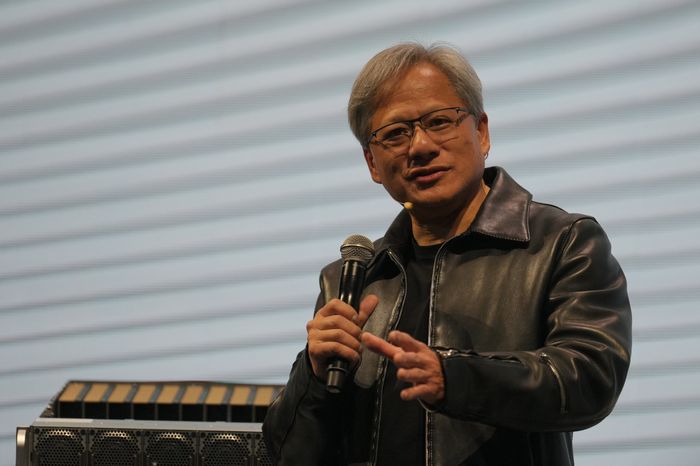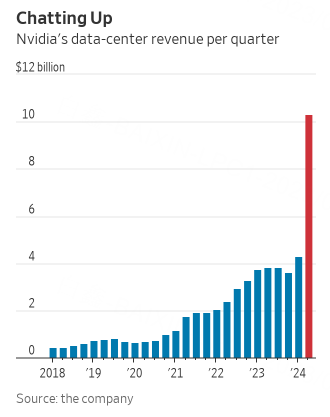Much of the world might think Nvidia's artificial-intelligence boom is a new thing. It has actually been a very long time in coming and will likely last a while too.
Nvidia has been at the AI game for more than a decade now. The company began touting its Cuda programming language used by AI developers to investors as early as 2006, according to transcripts compiled by S&P Global Market Intelligence. That technology formed the foundation of a business to sell the graphics processors once used mainly in videogames to data center operators seeking more-advanced computing capabilities. Nvidia's data center business crossed the $1 billion mark in annual revenue five years ago and recently surpassed the size of its videogaming business.
Even so, its most recent numbers are astonishing. Nvidia on Wednesday reported $13.5 billion in revenue for its fiscal second quarter, making its blowout forecast of $11 billion three months ago look like a lowball for the ages. Nvidia's business has basically doubled in size compared with the same quarter last year, and that is almost entirely a result of booming demand for the company's latest artificial-intelligence chips, which are being snapped up by tech giants building generative AI services.
That demand drove Nvidia's data center revenue to $10.3 billion in the recent quarter -- a huge jump for a business that was running at less than $4 billion a quarter just six months ago. Wednesday's report trounced Wall Street's already-soaring expectations. Analysts had projected just under $8 billion in data center revenue for the second fiscal quarter. The surprise gave more lift to a stock that had already made Nvidia the first chip maker valued at more than $1 trillion. The shares jumped more than 6% in after-hours trading after having more than tripled since the start of the year.
Such a run obviously can't last forever, but Nvidia gave strong indications Wednesday evening that its ride is far from over. The company projected about $16 billion in revenue for the current fiscal quarter -- nearly double the highest quarterly revenue it had ever reported before Wednesday. Chief Financial Officer Colette Kress said on the company's earnings call that its "demand visibility" extends into next year and that it expects to be able to increase the availability of its chips over the next several quarters.
"We're not shipping close to demand," Chief Executive Officer Jensen Huang told The Wall Street Journal in a later interview.
Nvidia's biggest customers seem to agree. In their recent financial reports for the quarter ended in June, Microsoft, Amazon.com and the parent companies of Google and Facebook signaled a strong intention to keep spending on generative AI capabilities even as they moderate other areas of their capital investments. Microsoft, which kicked off the rush into generative AI services, had a record $8.9 billion in capital expenditures in the June quarter, and the company expects that amount to increase sequentially every quarter in its new fiscal year as it boosts investments in "AI infrastructure."
Nvidia's biggest risk over the longer term might actually be its amazing success now. The company's chips and software ecosystem for AI are far ahead of the competition and thus confer strong pricing power. Nvidia's adjusted operating margins for the most recent quarter hit 58% -- the highest in at least a decade and a sharp jump from the 39% the company averaged over the previous eight quarters.
Stunning results like that will spur further competition. Advanced Micro Devices is launching new AI chips later this year to compete with Nvidia's, and companies including Google, Microsoft and Amazon have their own in-house chip efforts that aim to lessen their reliance on outside suppliers. Speaking of the latest generative AI systems, Amazon Chief Executive Officer Andy Jassy noted on his own earnings call earlier this month that "there's only been one viable option in the market for everybody, and supply has been scarce." He used the occasion to tout two of Amazon's own in-house chips, which are now in their second generation.
But Jassy also called out Nvidia's latest AI system -- known as H100 -- as driving strong demand by its own cloud customers. No other component supplier was afforded such a distinction. For Nvidia, the laws of supply and demand are firmly on its side for now.


Comments